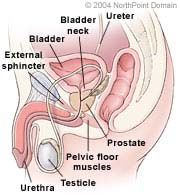Ultrasound

Basic Facts
- Ultrasound imaging allows urologists to examine the anatomy of organs, to aid in diagnosis of conditions, and may be used to assist in instrumentation during biopsies and other procedures.
- Duplex ultrasound combines basic ultrasound, which can show black-and-white images of abnormalities and obstructions, and Doppler ultrasound, which uses a short-pulsing probe to obtain colored images of the direction and speed of blood flow.
- The ultrasound transducer, the device that creates sound waves, can be either a hand-held scanner that glides over the body or an endoscopic probe that is inserted into body cavities.
Ultrasound is a painless, radiation-free diagnostic test that typically lasts for less than 30 minutes.Ultrasound equipment consists of a transducer (a device that creates sound waves) connected to a computer. The sound waves reflect off of internal tissues and return as echoes that a computer translates into a two-dimensional black-and-white image.
Some of the common applications of ultrasound in urology include:
- Renal ultrasound;
- Urinary bladder ultrasound;
- Prostate ultrasound; and
- Pelvic ultrasound.
Patients who may be unsuited for ultrasound include those who:
- Are morbidly obese (more than 100 lbs. overweight);
- Have just undergone an operation (if the area to be examined is located near the incision);
- Have abdominal scars (if the scar is near the area to be examined); or
- Have a large amount of gas in the bowel.
PRE-TEST GUIDELINES
Patients can undergo an ultrasound on an outpatient basis or as part of an inpatient hospital stay. There is no need for any special preparation for most ultrasound tests.
WHAT TO EXPECT
A skilled radiographic technician, or ultrasonographer, instructs the patient to lie down on a table and applies a conductive gel to the area of the body being examined. The technician will request that the person remain still during the test to ensure that images are clearly captured. The technician glides the transducer over the gel-covered area and may move it back and forth to emit sound waves through the skin, which bounce back to the transducer as echoes.
POST-TEST GUIDELINES
Following ultrasound, patients can resume normal activities.
POSSIBLE COMPLICATIONS
Ultrasound carries no identified risks and can be repeated as often as necessary.
Copyright © 2017 NorthPoint Domain, Inc. All rights reserved.
This material cannot be reproduced in digital or printed form without the express consent of NorthPoint Domain, Inc. Unauthorized copying or distribution of NorthPoint Domain’s Content is an infringement of the copyright holder’s rights.

